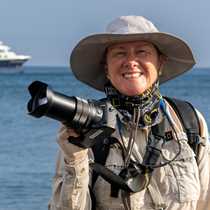Española Island
A light sleep-in had us waking up later than normal, surrounded by Gardner Bay on the northern shoreline of Española Island. Protected from the southeast trade winds gently starting to make its presence known now that we have entered the month of April, the morning was slightly overcast, but by the time the snorkelers reached Turtle Island for our last dive into the clear waters of Galápagos, the sun came out and brought the blues, greens and whites from the world. The fish were there, as were the sea lions on the long, pristine Gardner Bay beach. The word “beach” just doesn’t do it justice; it is so much more than that. We lounged in the sun, soaking up the warmth that many wouldn’t feel for another few months up north after leaving tomorrow. Balsa logs washed up on shore provided temporary rafts on which to play in the surf, while others were joined by the natural inhabitants for rest. At times we found ourselves surrounded, after a sleepy roll or two brought brown, furry, sand-covered sleek shapes within inches of our own.
The afternoon closed with an astounding visit to Puerta Suarez on the westernmost point of the island. The albatross have arrived! Their arrival to the island signifies the beginning of the end; the end of the hot, wet season and the beginning of the cool, dry season, though we have a few more weeks to go before the famous “garua” (inversion layer) sets in. As large birds, the albatross find flying difficult in times of weak winds, waiting for the increasing trades from the southeast to tell them it is time to return to Española and start their reproductive cycle once again. Apparently the word is out, as we saw several waved albatross not only flying overhead, but on land. Mostly males, they are waiting impatiently for their mates to join them, attempting courtship with any female who dares to land too early. Others were starting to form rafts far off shore, only their white heads bobbing in the swells were visible with binoculars from the high bluffs overlooking the blowhole. The blue-footed boobies held their own as well in all the marvels of the afternoon, sky-pointing, dancing and mating. Female marine iguanas were finishing the final touches to their nesting burrows before returning dusty and tired to edges of the sea.
A remarkable finale to a wondrous week.
A light sleep-in had us waking up later than normal, surrounded by Gardner Bay on the northern shoreline of Española Island. Protected from the southeast trade winds gently starting to make its presence known now that we have entered the month of April, the morning was slightly overcast, but by the time the snorkelers reached Turtle Island for our last dive into the clear waters of Galápagos, the sun came out and brought the blues, greens and whites from the world. The fish were there, as were the sea lions on the long, pristine Gardner Bay beach. The word “beach” just doesn’t do it justice; it is so much more than that. We lounged in the sun, soaking up the warmth that many wouldn’t feel for another few months up north after leaving tomorrow. Balsa logs washed up on shore provided temporary rafts on which to play in the surf, while others were joined by the natural inhabitants for rest. At times we found ourselves surrounded, after a sleepy roll or two brought brown, furry, sand-covered sleek shapes within inches of our own.
The afternoon closed with an astounding visit to Puerta Suarez on the westernmost point of the island. The albatross have arrived! Their arrival to the island signifies the beginning of the end; the end of the hot, wet season and the beginning of the cool, dry season, though we have a few more weeks to go before the famous “garua” (inversion layer) sets in. As large birds, the albatross find flying difficult in times of weak winds, waiting for the increasing trades from the southeast to tell them it is time to return to Española and start their reproductive cycle once again. Apparently the word is out, as we saw several waved albatross not only flying overhead, but on land. Mostly males, they are waiting impatiently for their mates to join them, attempting courtship with any female who dares to land too early. Others were starting to form rafts far off shore, only their white heads bobbing in the swells were visible with binoculars from the high bluffs overlooking the blowhole. The blue-footed boobies held their own as well in all the marvels of the afternoon, sky-pointing, dancing and mating. Female marine iguanas were finishing the final touches to their nesting burrows before returning dusty and tired to edges of the sea.
A remarkable finale to a wondrous week.




